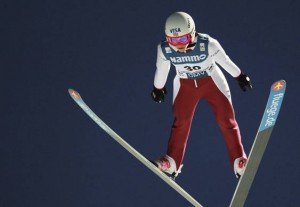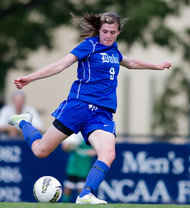During this time of year, we know that heroes are among us and "ordinary" people do extraordinary things (like "layaway angels"). Sports figures tend to be inspiring heroes to many throughout the hero, whether that adoration is deserved or not. One female athlete who definitely does deserve to be called a hero-- for her performance both on and off the athletic stage-- is world champion sk- jumper Lindsey Van. As I wrote about back in April, Van donated bone marrow to a man she has never met. When asked recently to donate again, to the same man, Van didn't hesitate (even as the donation process impacted her training for the World Cup season).
Van's long-held supremacy in ski-jumping may be coming to a close, as an up-and-coming American ten years her junior just won the first women's World Cup ski-jumping event. Sarah Hendrickson, at only 17, also qualifies as a Pint-Sized Phenom.
 It will be exciting to watch both Van and Hendrickson battle it out in the years leading up to 2014 Olympics in Sochi, the first year women's ski-jumping will be included in the Olympics (Van has previously sued to get it included, so I hope she will be able to compete in a few years)!
It will be exciting to watch both Van and Hendrickson battle it out in the years leading up to 2014 Olympics in Sochi, the first year women's ski-jumping will be included in the Olympics (Van has previously sued to get it included, so I hope she will be able to compete in a few years)!
Another exciting teen phenom is Kelly Cobb, a freshman soccer player at Duke. Cobb has emerged as a soccer star, albeit from an unlikely place: Alaska. A recent profile in The New York Times included some great tidbits-- like the horrible sunburn she got in NC because she's not used to playing outside, the time a moose interrupted her team's soccer game by standing in front of the goal, and an encounter with a black bear during an icy run. I have a feeling we'll be hearing much more from Cobb in the next decade or so.
While we all might cheer Cobb, Hendrickson, and Van from our couches, another group of women (some of whom definitely qualify as athletes) often cheer from the sidelines. Cheerleaders remain popular companions to male team sports like basketball and football. With the rise of competitive cheer many are considered athletes in their own rights. And now an organization wants to show you that they are brainy as well. "Science cheerleaders" are a group of current and former NFL and NBA cheerleaders who also hold science degrees and/or jobs in science. Check out their website to see how they promote science education through sports and cheer. I think it sounds like a neat organization that can positively impact young girls in a number of ways.
As cheerleading continues to evolve in interesting ways it's important to remember that barriers to participation by sex still exist in cheer, and in other sports. A cheer team in Michigan was recently disqualified from a statewide competition for having male cheerleaders. In this case having boys on the team isn't allowed, even though there isn't an option for males who want to participate. This is the opposite of how things work in Massachusetts (funny enough, MA is now my home state, though MI is where I grew up), as I've written about before. Boys are allowed to play on girls' field hockey teams and swim teams, which is sometimes met with resistance.
What do you think? Should girls be able to play on boys' teams (as often happens in wrestling, for example), and vice versa, when similar opportunities aren't available for both sexes?



